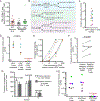The role of CD32 during HIV-1 infection
- PMID: 30232425
- PMCID: PMC6442722
- DOI: 10.1038/s41586-018-0494-3
The role of CD32 during HIV-1 infection
Abstract
Persistence of latent HIV-1 in long-lived resting memory CD4+ T cells is a major barrier to curing HIV-1 infection, and thus a biomarker for latently infected cells would be of great scientific and clinical importance.,,,, Through an elegant discovery-based approach, Descours et al. reported that CD32a, an Fcγ receptor not normally expressed on T cells, is a potential biomarker for latently infected cells. Using the quantitative viral outgrowth assay, we show that CD32+ CD4+ T cells do not harbor the majority of intact proviruses in the latent reservoir and that the enrichment found by Descours et al. may in part reflect the use of an ultrasensitive ELISA for HIV-1 p24 antigen that does not predict exponential viral outgrowth. Our studies show that CD32 is not a biomarker for the major population of latently infected CD4+ T cells.
Conflict of interest statement
Competing Financial Interests
The authors declare no competing financial interests.
Figures


Comment on
-
CD32a is a marker of a CD4 T-cell HIV reservoir harbouring replication-competent proviruses.Nature. 2017 Mar 23;543(7646):564-567. doi: 10.1038/nature21710. Epub 2017 Mar 15. Nature. 2017. PMID: 28297712
References
-
- Finzi D et al. Identification of a reservoir for HIV-1 in patients on highly active antiretroviral therapy. Science 278, 1295–1300 (1997). - PubMed
-
- Wong JK et al. Recovery of replication-competent HIV despite prolonged suppression of plasma viremia. Science 278, 1291–1295 (1997). - PubMed
-
- Richman DD et al. The challenge of finding a cure for HIV infection. Science 323, 1304–7 (2009) - PubMed
Publication types
Grants and funding
LinkOut - more resources
Full Text Sources
Other Literature Sources
Research Materials
Miscellaneous

